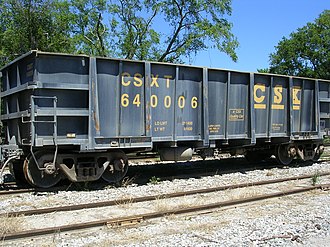AY Honors/Model Railroad/Answer Key
- For other uses, see Gondola (disambiguation)

In railroad terminology, a gondola is an open-top type of rolling stock that is used for carrying loose bulk materials. Because of its low side walls, gondolas are used to carry either very dense material, such as steel plates or coils, or bulky items such as prefabricated pieces of rail track.
History
Early gondola cars had low sides. Their contents had to be shoveled out by hand and they took a long time to unload. In 1905, the Ralston Steel Car Company patented a flat bottom gondola with lever operated chutes that allowed the gondola to be unloaded automatically from the bottom. The chutes would direct the contents of the gondola to the sides. This coincided with the switch from wood to steel freight cars as the pulling force of locomotives tended to crush the older wood cars.
Specialized car types
Coil car (rail)
Lorry
An open railroad car (gondola) with a tipping trough, often found in mines.
Track ballast gondolas
"Bathtub" gondolas

In the second half of the 20th century, coal haulage shifted from open hopper cars to high-sided gondolas. Using a gondola, the railroads are able to haul a larger amount of coal per car since gondolas do not include the equipment needed for unloading. However, since these cars do not have hatches for unloading the products shipped in them, railroads must use rotary car dumpers (mechanisms that hold a car against a short section of track as the car and track are slowly rotated upside down to empty the car) or other means to empty them. The term "bathtub" refers to the shape of the car.
Container well cars
These specialized gondolas are designed to carry shipping containers. A depressed center section provides a floor which is only inches above the rails. This stabilizes the container by lowering the center of gravity, also allowing double-stacking, which would be impossible if the containers were placed on a flatcar. Single-unit well cars exist, but 3- and 5-car articulated sets are common. These reduce weight by reducing the number of trucks by nearly half, and also reduce the amount of slack in the train since there are fewer couplers. This protects the cargo by reducing the jolts that occur at starting and stopping caused by slack.
Modalohr road trailer carriers
Specialized railroad cars carrying road trailers and road tractors on a route from France to Italy and Luxembourg to Spain and vice versa. A deck between the bogies (trucks) pivots (swings) 30°, allowing the trailers to be loaded from the sides. For details see the official sites Rail-route or Modalohr
References
- Double Stack Intermodal Cars-Freight doublestackinter
See also
External links
- Atchison, Topeka and Santa Fe Railway #72312 — photos and short history of an example of a typical steel, four-axle, solid bottom, fixed end, mill gondola.



